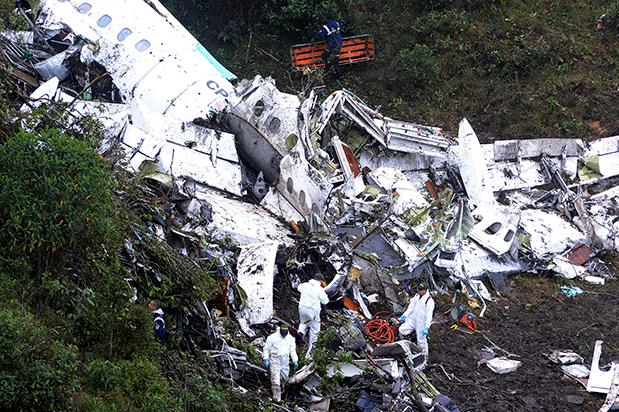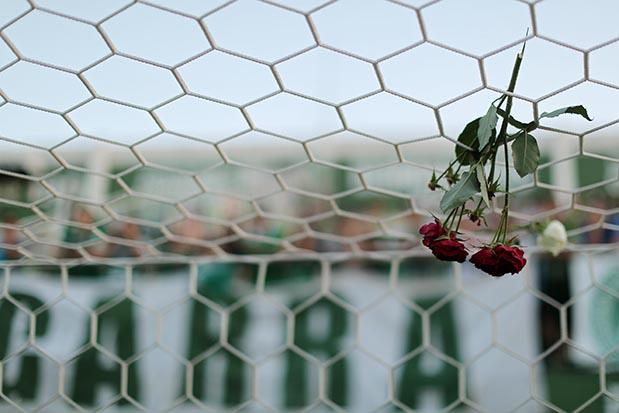With the unfathomably tragic events surrounding Associação Chapecoense de Futebol and the horrifying plane crash in Colombia that has so far claimed 71 lives, including almost the entire playing list of the club, the focus has now shifted to not only the family, friends, and fans of the players, staff, and journalists who lost their lives, but how the sport itself will respond and react.
In an immediate sense,
Atletico Nacional, who were scheduled to face
Chapecoense in the final of the
Copa Sudamerica prior to yesterday’s unspeakable tragedy, have asked governing body
CONMEBOL to award the tournament and trophy to Chapecoense in a mark of respect.
“Atletico Nacional have invited Conmebol to deliver the Copa Sudamericana title to the Chapecoense Football Association as an honour for their great loss and in posthumous homage to the victims of the tragic accident that has our sport in mourning.”
“For us, and forever, Chapecoense shall be the Copa Sudamericana champions for 2016.”
Quite obviously, it’s going to take Chapecoense some time to recover from the disaster – if indeed they are ever able to fully recover. The club is not a financial powerhouse, and hails from a city with a population of just over 200,000.
But what if, heaven forbid, such a disaster were to befall a club from a more prominent, western professional sporting league?
What might actually surprise you is that numerous pro-leagues have contingency policies in place in the unlikely event of such a disaster occurring. But in terms of Australia, the answers aren’t exactly super-clear.
Firstly, let’s look at the US.
All 5 major professional sporting organisations in the US have dedicated policies for things called a “Disaster Draft,” or “extreme hardship” provisions; policies that are designed to aid a club in the event that multiple players suddenly become disabled, or indeed die, during the course of an active season.
The NFL has a contingency plan that accounts for what it defines as “near-disaster” and “disaster” situations. In this case, a “near-disaster” is deemed to be a situation where fewer that 15 players on a team are disabled or killed, with a disaster applying for situations involving 15 or more.
Under near-disaster circumstances, a team would get preferential rights on player waivers until the end of that current season, meaning they have first right of choice on any player whose contract has been waived by other teams. If a quarterback is among those affected by the incident, the team would then be able to select up to two temporary quarterbacks from NFL teams who have three QBs available. Each NFL team would be able to protect two QBs, and the drafted quarterbacks would effectively be on loan; returning to their original team at the beginning of the next season.
In the full-blown disaster scenario, the NFL Commissioner would then assess whether to cancel the affected team’s season, giving them the number one pick in the next NFL Draft as a result. A special disaster draft would also be held in order to assist the crippled club recover and move forward.
The NBA‘s rules are a little more straightforward on the matter. Coming into effect when five or more players are killed or disabled, the league then activates a special disaster draft. Other teams can protect only 5 players, and the affected team can then re-fill their roster by taking a maximum of one player from each side.
Major League Baseball‘s policy involves a “Restocking Draft” that stipulates an affected club can select as many players as they lost from a pool of 5 nominated by each non-affected club. Each team not affected by a disaster nominates a pitcher, catcher, outfielder, infielder, and one other from any position. Again, a disaster-affected team can only select a maximum of one player from each club.
The National Hockey League also operates their disaster policies on this structure, with player payments coming from a special insurance fund.
And finally, while Major League Soccer does contain a provision for “extreme hardship” in their roster policies, events are dealt with on a “game-by-game” basis, and as such dedicated disaster policies are not available to the public.
But what of Australia? What if, for example, the AFL was suddenly faced with such a disaster?
Immediate details on disaster policies are not readily available through any of the AFL’s publicly accessible policy documents and player agreements. But a closer look at some of the finer details reveals a spate of policies that could potentially apply to such a devastating situation.
Understandably, the AFL isn’t particularly keen on relaying their official policy to the public, particularly in the wake of a tragedy like this one.
Speaking to PEDESTRIAN.TV, the AFL’s chief media manage Patrick Keane detailed the league’s position thusly:
“Under the AFL player rules, our commission has the power to act if a club is significantly impacted but this is a real life tragedy for a club and another sport, and we’d rather not detail how our rules operate out of courtesy for what has occurred here.”
But there are clues as to how the league might handle such a situation contained within their rules and regulations.
In the immediate aftermath of a disaster, the AFL would likely implement section
33.1a of their standard regulations, which deals with the abandonment of games due to circumstances beyond a club’s control:
“If a Match is unable to commence for reasons beyond the control of the Club,
the General Manager – Football Operations shall endeavour to reschedule the
Match so that a result can be obtained. If the Match cannot be rescheduled,
each Team shall be awarded two Premiership Points and the Teams’
percentage shall not be adjusted.”
This rule was applied in the wake of Adelaide Crows‘ senior coach Phil Walsh‘s tragic death in July 2015, with the scheduled game between Adelaide and the Geelong Cats set for that following weekend abandoned, with each club receiving two premiership points. To date, it’s the only game that has been outright cancelled in AFL history.
The AFL has also, in the past, not been a stranger to tragedy on an individual scale. Since the league nationalised as the Australian Football League in 1990, three young players have sadly died whilst serving time on an AFL club list. In 1991, Collingwood premiership player Darren Millaine was killed in a car accident whilst driving drunk. Melbourne defender Troy Broadbridge was one of the scores of people who lost their lives in the 2004 Boxing Day Tsunami whilst on his honeymoon in Thailand. And in 2012, 22-year-old Port Adelaide player John McCarthy died after becoming disoriented on an end-of-season trip to Las Vegas, where he fell to his death after leaping from the roof of the Flamingo casino in an attempt to climb down a palm tree.
In each case, the AFL did not provide special list concessions or provisions for the clubs, instead classifying each deceased player as an immediate delisting. Clubs were able to fill the hole in their playing list by either drafting in the standard AFL National Draft, or by elevating a player on their rookie list to the main roster.
“If a Player dies or becomes permanently disabled (as that term is defined in the AFL
Insurance Policy) as a result of an injury which occurs in the course of the Player’s
employment as an AFL footballer, including travelling to and from training, Matches or
other activities authorised by the AFL Club, the Player shall be entitled to claim up to $1
million in accordance with the AFL’s Insurance Policy.”
These are all policies that deal with cases involving individuals, of course. But how would the AFL cope with a mass-tragedy on the scale of the one that’s befallen Chapecoense?
The answer to that actually comes from this past season.
When 34 past-and-present players of the Essendon Football Club were suspended for the year by the Court of Arbitration for Sport back on January 12th, it left the Bombers with a sudden, gaping hole in their side where 12 players once stood.
Despite suggestion the team could forfeit the season entirely, the AFL immediately set rules into place allowing the club to seek temporary relief.
The club was allowed to select up to 10 “top-up” players, sourced from the club’s second-tier VFL side, and from the list of players delisted from other AFL clubs in the past two years. The guidelines for selection were extremely similar to other set disaster plans from other codes: a maximum of one player from any given club.
That right there? That’s a disaster plan. The Essendon supplements saga has, for all intents and purposes, revealed the framework for how the AFL would cope with a tragedy on the levels of the one facing Chapecoense.
We just hope and pray to dog almighty that it’s a plan that’ll never have to be enacted out here.
Photo: Will Russell/AFL Media, LatinContent/STR, Hueler Andry – All Getty Images.











